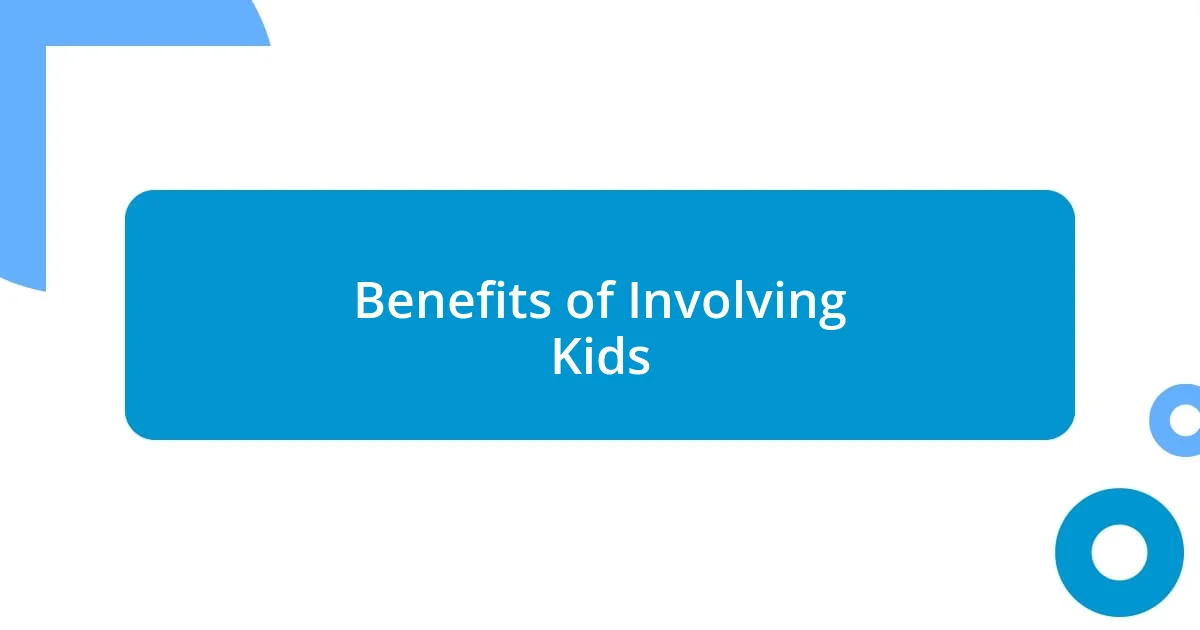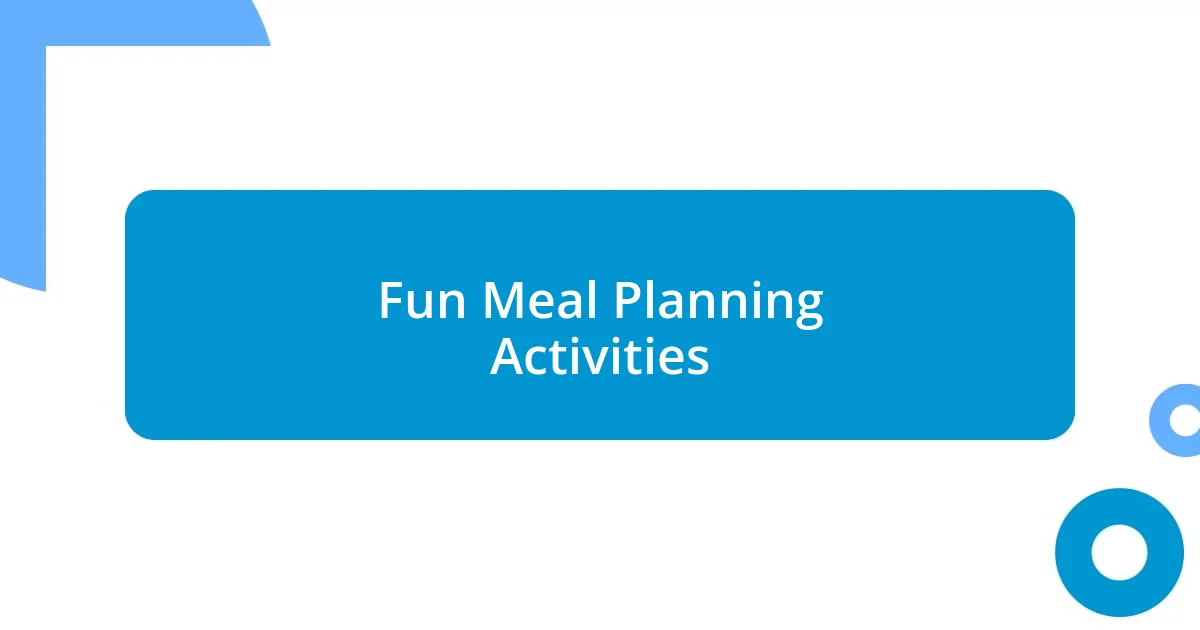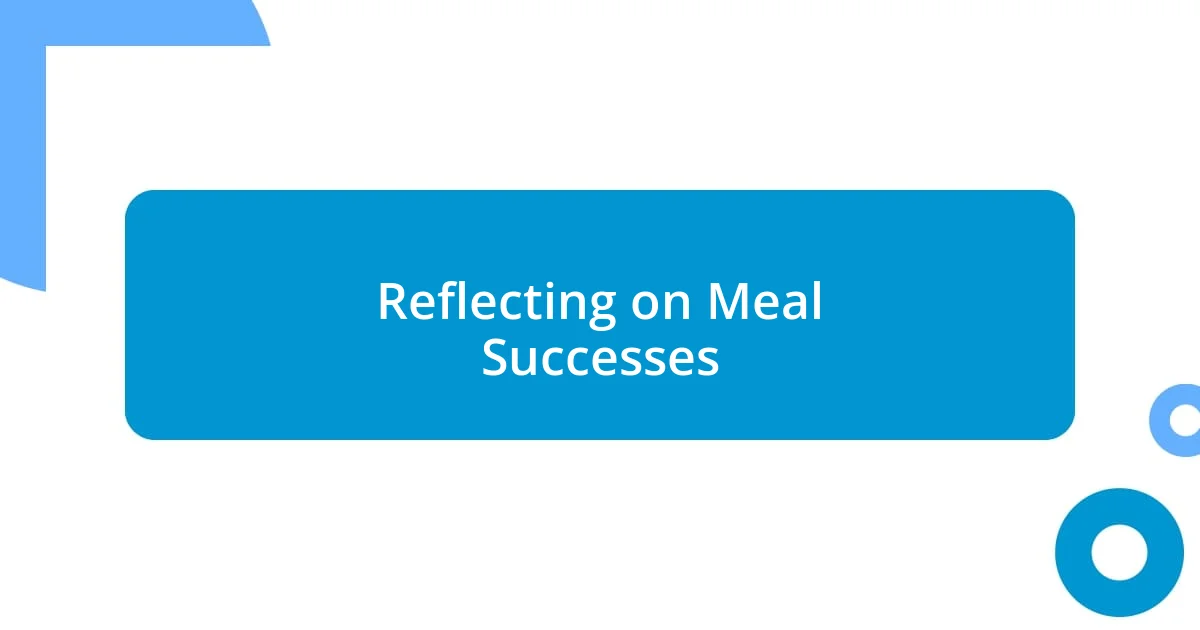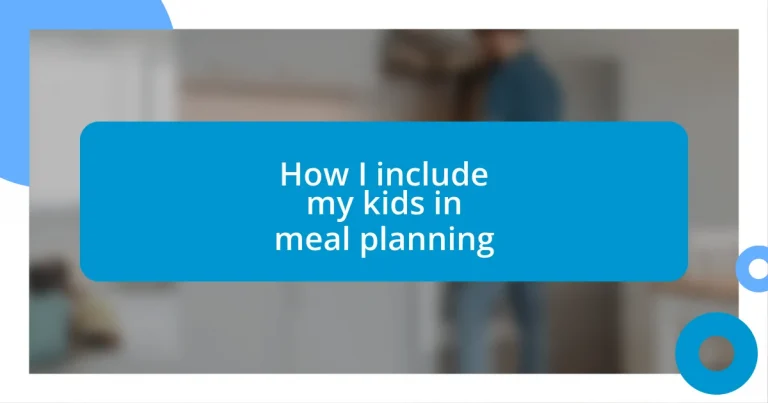Key takeaways:
- Involving kids in meal planning fosters excitement, creativity, and a sense of ownership over their food choices.
- Engaging children in fun activities like the “Mystery Ingredient Challenge” and family cooking nights strengthens family bonds and encourages healthy eating habits.
- Reflecting on meal successes and failures teaches kids about resilience, ownership, and the joy of cooking together.

Benefits of Involving Kids
Involving kids in meal planning can transform family dynamics in delightful ways. I’ve noticed that when my children help choose meals, they seem more excited to eat what’s prepared. It’s like a sense of ownership—they’re not just passive participants but active contributors.
One time, when my daughter suggested taco night, she brought her own flair to it by wanting pineapple salsa. I was hesitant at first, but her enthusiasm won me over. The result? A joyful night filled with laughter and unexpected flavor. It made me realize how embracing their ideas fosters creativity, not just in the kitchen but in their understanding of food.
Moreover, collaborating on meals offers an excellent opportunity to teach kids about nutrition and cooking. I often ask my son, “What do you think makes a balanced plate?” His responses often surprise me. When they engage in this way, it’s more than just meal prep; it’s about empowering them with knowledge that lasts a lifetime.

Steps to Get Started
To get started with including kids in meal planning, I always find it helpful to set a fun tone. I gather my children around the kitchen table with a few colorful recipe cards and some of their favorite cookbooks. This makes it feel less like a chore and more like an adventure where they can explore their tastes and preferences.
Here’s a simple list of steps to kick off the process:
- Set a Schedule: Designate a day each week for meal planning together.
- Gather Inspiration: Provide them with kid-friendly cookbooks, magazines, or apps to spark ideas.
- Create a Menu Board: Use a whiteboard or poster to jot down their suggestions. This way, they can visualize the meals they want to try.
- Incorporate Themes: Consider theme nights, like “Italian Night” or “Taco Tuesday,” to get their creative juices flowing.
- Make It Collaborative: Encourage them to choose one meal each to make during the week; it gives them ownership and excitement.
My son once asked if we could have an “Around the World” week, where each meal represented a different country. I was taken aback but thrilled by the idea! We ended up making curry from India and sushi from Japan. Sharing these cooking experiences not only expanded their palates but also brought us closer as a family, sparking conversations about different cultures.

Fun Meal Planning Activities
When it comes to meal planning, I’ve found that making it a game can really ignite my kids’ enthusiasm. One of our favorite activities is a “Mystery Ingredient” challenge. Each week, we pick a unique ingredient from the pantry and brainstorm meals that feature that item. The other day, we chose quinoa, and my kids didn’t just come up with a salad; they concocted delightful quinoa patties, which became our new favorite snack. Seeing them light up with creativity is truly a joy!
Another fun activity is organizing a “Family Recipe Night.” Each member of our family gets to choose a beloved dish, and we dedicate one evening to prepare it together. Recently, my son chose his grandmother’s lasagna recipe. The laughter and chaos that ensued in the kitchen made it memorable, and it was heartwarming to share stories as we cooked. It’s moments like these that make meal planning not just a task, but a cherished family tradition.
I also love involving my kids in a “Grocery Store Challenge.” We make a list of healthy items together, then split into teams, racing through the grocery store to see who can find everything on the list first. It’s a fun way to teach them about making good food choices while promoting a little friendly competition!
| Activity | Description |
|---|---|
| Mystery Ingredient Challenge | Pick a unique ingredient to inspire meal ideas. |
| Family Recipe Night | Choose a family dish to prepare together. |
| Grocery Store Challenge | Split into teams to find healthy ingredients from a list. |

Creating a Weekly Menu
Creating a weekly menu is not just about choosing meals; it’s an opportunity to foster creativity and decision-making skills in my kids. As we sit down to brainstorm together, I often ask them what flavors or dishes they’ve been curious to try. This simple question can lead to surprises, like the time my daughter suggested making homemade sushi. The joy on her face while rolling the rice and veggies was priceless!
During our menu planning sessions, I like to suggest a mix of tried-and-true family favorites alongside new recipes. It creates a balance that appeals to both kids and adults, and I’ve noticed that my children are more willing to try something new when they see familiar dishes on the menu. One week, I included a familiar mac and cheese alongside a new spicy veggie stir-fry. The mix sparked a lively discussion about flavors, preferences, and even the occasional food-related debate!
Visual aids also play a key role in our meal planning. We use charts to display our weekly menu, featuring colorful drawings and sticky notes to represent meals. Just the other day, my son excitedly pointed at a note he had added for “Pizza Night” and said, “Can we make a veggie pizza and decorate it like a rainbow?” His excitement was infectious, and we ended up planning an entire dinner around his colorful idea! Engaging them in this way not only helps them feel valued but also makes the process enjoyable for all of us.

Encouraging Healthy Choices
When I think about fostering healthy choices, involving my kids in selecting fruits and vegetables is key. The other day, we went to the farmers’ market together. I encouraged my kids to pick out their favorite produce, and they ended up choosing bright bell peppers and juicy strawberries. Their excitement made me realize that when they take ownership of what goes into our meals, they’re more inclined to eat those foods happily.
I’ve also found that making nutrition a topic of discussion sparks curiosity. For instance, during dinner, I casually bring up how certain foods benefit our bodies. One evening, I explained how carrots help our eyesight, and my daughter asked if they could help her see in the dark. It’s fascinating how these little conversations can lead kids to not only enjoy healthy foods but also understand why they matter to our overall well-being.
In our house, we sometimes create “color themes” for the week. For example, I might say, “This week is all about greens!” It’s fun to get creative with various green foods, from leafy kale salads to vibrant avocado toast. Not only does this approach keep things interesting, but it also motivates my kids to explore new healthy options, making the whole process feel like an adventure. Who doesn’t love a little friendly challenge, especially when it ends with a delicious meal?

Making Shopping a Family Event
Shopping for groceries with my kids has turned into a cherished family event. One Saturday morning, we decided to head to our local grocery store together, and I let my children lead the way. As we walked down the aisles, they eagerly shared their thoughts on what we should buy. My son spotted a huge display of colorful fruits and shouted, “Let’s get the biggest watermelon!” His enthusiasm made what could have been a mundane chore into a fun treasure hunt.
I’ve also learned that collaboration during shopping encourages teamwork. There was a hilarious moment when my daughter insisted on comparing prices for her favorite snack. She picked up two different brands and broke into a serious debate about which one had more chips. It made me realize that these little discussions not only teach them about budgeting but also strengthen our bond through shared decision-making. It’s amazing how a simple act like choosing snacks can spark such meaningful interactions.
When we finally check out, I always ask them to share what their favorite part of the trip was. The other day, my son said, “When we found the special cereal!” That moment made me smile because it reinforced how much they enjoy being part of the process. I truly believe that making shopping a family event instills a sense of pride in our meals, and it transforms the act of grocery shopping from a chore into treasured family memories.

Reflecting on Meal Successes
Reflecting on our meal successes always gives me a sense of achievement. Last week, after trying a new recipe together, my daughter burst out with, “This is the best dinner ever!” In that moment, I realized how the effort we put into planning and cooking had paid off, not just in taste but in shared joy. It’s moments like these that remind me why involving my kids in our meal planning is so valuable.
I often sit down with my kids after a meal to discuss what we enjoyed most. Just the other day, my son excitedly pointed out how he loved the homemade tacos we made together, and I could see his pride in having a hand in crafting them. These reflections inform our future meal plans, as they help my children recognize their preferences and understand the value of their contributions. Isn’t it delightful when kids take ownership of their food?
Celebrating successes also means acknowledging the challenges we’ve faced. I remember when we attempted a complex stir-fry and it turned out a little soggy. Instead of being discouraged, we laughed about it and brainstormed how to make it better next time. This approach fosters a growth mindset, teaching my kids that every cooking experience—successful or not—invites learning. How rewarding it is to cultivate resilience in the kitchen and beyond!














